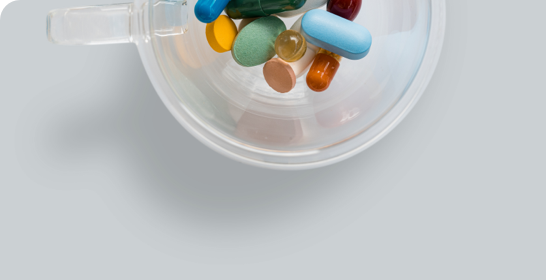We use cookies to make your experience better. To comply with the new e-Privacy directive, we need to ask for your consent to set the cookies. Learn more.
CoffeWin - LC50 - Green Coffee [Coffea L.] bean 50% Chlorogenic acid [Caffeine ≤ 2%] powder extract
Synonym(s):
- CoffeWin; Green Coffee bean; Coffea L. bean; Chlorogenic acid
- CAS Number: 327-97-7 [Chlorogenic acid]; 97593-13-0 [Green Coffee extract]
- EC Number: 307-315-5 [Green Coffee extract]
CoffeWin - LC50 - Green Coffee [Coffea L.] bean 50% Chlorogenic acid [Caffeine ≤ 2%] powder extract
CoffeWin Key Facts
- CoffeWin is a 100% natural Green Coffee extract produced by proprietary hydro-alcoholic extraction process
- CoffeWin is standardised to chlorogenic acid and total polyphenols [HPLC]
Background
Coffee is probably the most widely consumed beverage in the world, after water. While it is often consumed for its caffeine content and subsequent stimulant effects, the health benefits of coffee are often overlooked by many. Coffee contains a substance called chlorogenic acid (CA). This is a phenolic acid compound from the hydroxycinnamic acid family, found specifically in green coffee beans (Santana-Gálvez et al., 2017). Green coffee is the raw, unroasted, unprocessed and natural form of the coffee bean. CA is a commonly used polyphenol compound due to evidence support its use as an antioxidant, antidiabetic, cardioprotective and neuroprotective agent amongst numerous other uses (Naveed et al., 2018).At present we have the following variants of CoffeWin
CoffeWin - LC50 - Green Coffee [Coffea L.] bean 50% Chlorogenic acid [Caffeine ≤ 2%] powder extractCoffeWin - HC10 - Green Coffee [Coffea L.] bean 70 Caffeine/ 10% Chlorogenic acid powder extract
Chemistry
The structure of CA is a combination of two molecules, a caffeic acid molecule bound to a Quinic Acid moiety and is therefore sometimes known as 5-caffeoylquinic acid (5-CQA). When ingested CA undergoes metabolism into various bioactive metabolites (Olthof et al., 2003).CAS – 327-97-9
Chemical Formula – C16H18O9
Molecular Weight – 354.31 g/mol
IUPAC – (1S,3R,4R,5R)-3-[(E)-3-(3,4-dihydroxyphenyl)prop-2-enoyl]oxy-1,4,5-trihydroxycyclohexane-1-carboxylic acid
Chlorogenic Acid and Health
Many of Chlorogenic Acid’s benefits surround its ability to aid weight loss and improve health markers in overweight individuals. For example, oxidative stress accumulates in fat and chronic inflammation which can occur as a result of excess fat are both linked to the development of metabolic syndrome and therefore treatment of these is crucial (Naveed et al., 2018). With clear evidence demonstrating its anti-inflammatory and anti-oxidant abilities, chlorogenic acid can be beneficial in these circumstances (Tajik et al., 2017).Weight Management & Blood Glucose Control
Acutely, Chlorogenic Acid is able to reduce the insulin and glucose spikes that are seen following the consumption of a meal (van Dijk et al., 2009). While longer-term consumption can reduce carbohydrate uptake in the intestine (Thom, 2007). CA is not well absorbed by the intestine which is important as this is the site of action for the reduced glucose uptake. In the intestine, it is though that CA acts as an alpha-glucosidase inhibitor (Benalla et al., 2010; Tunnicliffe et al., 2011).CA can also increase muscular glucose uptake, firstly by stimulating AMP-activated protein kinase (AMPK) and secondly by phosphorylating Akt which both lead to the translocation of the glucose transporter GLUT4. This ultimately increases glucose transport into skeletal muscle (Ong et al., 2012). As well as this, CA may potentially also inhibit the enzyme glucose-6-phosphatase (G6P) and therefore reduce the amount of glucose produced by via gluconeogenesis and glycogenolysis in the body which can be beneficial in the treatment of type 2 diabetes, a common comorbidity in overweight individuals (Henry-Vitrac et al., 2010).
While the antidiabetic and anti-obesity properties of CA are mainly linked to its effects on the metabolism of glucose, CA may also be able to induce body fat loss by acting as a PPAR-alpha agonist and increasing body heat produced, as well as potentially reducing the proliferation of new fat cells due to its antioxidant effects (Cho et al., 2010; Hsu et al., 2006).
Individuals who are overweight often develop hypertension which is associated with numerous health risks (Landsberg et al., 2012). CA appears to exert an anti-hypertensive effect, reducing blood pressure (Watanabe et al., 2006). This effect is due to the ability of ferulic acid, a CA metabolite, to increase vasoreactivity and as well as it having a general blood pressure lowering ability (Ochiai et al., 2004; Suzuki et al., 2002).
Dyslipidemia is a common occurrence in overweight individuals and is linked to disorders such as non-alcoholic fatty liver disease and cardiovascular disease (Tajik et al., 2017). Evidence has shown that CA could potentially decrease liver and plasma triglyceride concentrations, resulting in a more favourable blood lipid profile (Rodriguez de Sotillo & Hadley, 2002).
Antioxidant
Chlorogenic acid has been identified as a strong antioxidant due to its structure, meaning it reacts easily with free radicals and can form hydrogen radicals with an antioxidant effect to eliminate hydroxyl radicals, superoxide anions, as well as scavenging 2-diphenyl-1-picrylhydrazyl radicals, and 2,2ʹ-azino-bis (3-ethylbenothiazoline-6-sulfonic acid) cation radicals, and also reacting with the oxidising agent peroxynitrite (Miao & Xiang, 2000; Nabavi et al., 2017) and this antioxidant ability is linked to CA’s blood-pressure lowering effect. It has been observed that there are higher levels of oxidative stress in hypertensive humans as seen through elevated levels of hydrogen peroxide and superoxide anions. These superoxide anions decrease nitric oxide bioavailability in endothelial tissue and this nitric oxide deficiency has been touted as a cause of hypertension. Due to CA’s antioxidant ability, it has been proposed that it can improve endothelial dysfunction, aiding the reduction of blood pressure (Santana-Gálvez et al., 2017).Ca is also a protective agent against alcoholic liver disease through its function as an antioxidant. CA scavenges reactive oxygen species and reduce oxidative stress that occurs when the liver is exposed to alcohol. This results in the attenuation of DNA damage and the inflammatory response-induced activation signaling pathways in hepatocytes, ultimately inhibiting the development of alcoholic liver injuries such as steatosis, hepatocyte apoptosis, and hepatic-fibrosis (Kim et al., 2018).
Neuroprotection
It has been reported that either CA or its metabolites may have the unique ability cross the blood-brain barrier and therefore have the ability to exert a neuroprotective effect on brain tissue .CA exerts a neuroprotective effect through its ability to act as an antioxidant in neurons against hydrogen peroxide induced stress (Kim et al., 2012). As well as this, CA may also preserve dopaminergic neurons by suppressing neuroinflammation which could help protect against Parkinson’s Disease (Shen et al., 2012). As well as this, CA may also inhibit apoptotic processes in neuronal cells (Nabavi et al., 2017).Cancer
It has been suggested that cellular damage caused by reactive oxygen species is linked to the development of cancer (Tajik et al., 2017). CA’s has demonstrated involvement in anti- and pro-oxidant actions, anti-inflammatory effects, anti-angiogenic effects, and apoptosis-inducing activity all of which can help with the prevention of cancer (Hayakawa et al., 2020). CA has also been shown to inhibit the proliferation of some human colon cancer cells as well as showing an anti-cancer effect against colorectal cancer cells (Hou et al., 2017).Trademark
CoffeWin is a trademark of Vita Actives, EU trademark number 013810866.References
- Benalla, W., Bellahcen, S. and Bnouham, M., 2010. Antidiabetic Medicinal Plants as a Source of Alpha Glucosidase Inhibitors. Current Diabetes Reviews, 6(4), pp.247-254.
- Cho, A., Jeon, S., Kim, M., Yeo, J., Seo, K., Choi, M. and Lee, M., 2010. Chlorogenic acid exhibits anti-obesity property and improves lipid metabolism in high-fat diet-induced-obese mice. Food and Chemical Toxicology, 48(3), pp.937-943.
- Hayakawa, S., Ohishi, T., Miyoshi, N., Oishi, Y., Nakamura, Y. and Isemura, M., 2020. Anti-Cancer Effects of Green Tea Epigallocatchin-3-Gallate and Coffee Chlorogenic Acid. Molecules, 25(19), p.4553.
- Henry-Vitrac, C., Ibarra, A., Roller, M., Mérillon, J. and Vitrac, X., 2010. Contribution of Chlorogenic Acids to the Inhibition of Human Hepatic Glucose-6-phosphatase Activity in Vitro by Svetol, a Standardized Decaffeinated Green Coffee Extract. Journal of Agricultural and Food Chemistry, 58(7), pp.4141-4144.
- Hou, N., Liu, N., Han, J., Yan, Y. and Li, J., 2017. Chlorogenic acid induces reactive oxygen species generation and inhibits the viability of human colon cancer cells. Anti-Cancer Drugs, 28(1), pp.59-65.
- Hsu, C., Huang, S. and Yen, G., 2006. Inhibitory Effect of Phenolic Acids on the Proliferation of 3T3-L1 Preadipocytes in Relation to Their Antioxidant Activity. Journal of Agricultural and Food Chemistry, 54(12), pp.4191-4197.
- Kim, H., Pan, J., Kim, S., Lee, J. and Park, J., 2018. Chlorogenic acid ameliorates alcohol-induced liver injuries through scavenging reactive oxygen species. Biochimie, 150, pp.131-138.
- Kim, J., Lee, S., Shim, J., Kim, H., Kim, J., Jang, Y., Yang, H., Park, J., Choi, S., Yoon, J., Lee, K. and Lee, H., 2012. Caffeinated coffee, decaffeinated coffee, and the phenolic phytochemical chlorogenic acid up-regulate NQO1 expression and prevent H2O2-induced apoptosis in primary cortical neurons. Neurochemistry International, 60(5), pp.466-474.
- Landsberg, L., Aronne, L., Beilin, L., Burke, V., Igel, L., Lloyd-Jones, D. and Sowers, J., 2012. Obesity-Related Hypertension: Pathogenesis, Cardiovascular Risk, and Treatment. The Journal of Clinical Hypertension, 15(1), pp.14-33.
- Miao, M. and Xiang, L., 2020. Pharmacological action and potential targets of chlorogenic acid. Pharmacological Advances in Natural Product Drug Discovery, pp.71-88.
- Nabavi, S., Tejada, S., Setzer, W., Gortzi, O., Sureda, A., Braidy, N., Daglia, M., Manayi, A. and Nabavi, S., 2017. Chlorogenic Acid and Mental Diseases: From Chemistry to Medicine. Current Neuropharmacology, 15(4), pp.471-479.
- Nabavi, S., Tejada, S., Setzer, W., Gortzi, O., Sureda, A., Braidy, N., Daglia, M., Manayi, A. and Nabavi, S., 2017. Chlorogenic Acid and Mental Diseases: From Chemistry to Medicine. Current Neuropharmacology, 15(4), pp.471-479.
- Naveed, M., Hejazi, V., Abbas, M., Kamboh, A., Khan, G., Shumzaid, M., Ahmad, F., Babazadeh, D., FangFang, X., Modarresi-Ghazani, F., WenHua, L. and XiaoHui, Z., 2018. Chlorogenic acid (CGA): A pharmacological review and call for further research. Biomedicine & Pharmacotherapy, 97, pp.67-74.
- Ochiai, R., Jokura, H., Suzuki, A., Tokimitsu, I., Ohishi, M., KOMAI, N., RAKUGI, H. and OGIHARA, T., 2004. Green Coffee Bean Extract Improves Human Vasoreactivity. Hypertension Research, 27(10), pp.731-737.
- Olthof, M., Hollman, P., Buijsman, M., van Amelsvoort, J. and Katan, M., 2003. Chlorogenic Acid, Quercetin-3-Rutinoside and Black Tea Phenols Are Extensively Metabolized in Humans. The Journal of Nutrition, 133(6), pp.1806-1814.
- Ong, K., Hsu, A. and Tan, B., 2012. Chlorogenic Acid Stimulates Glucose Transport in Skeletal Muscle via AMPK Activation: A Contributor to the Beneficial Effects of Coffee on Diabetes. PLoS ONE, 7(3), p.e32718.
- Rodriguez de Sotillo, D. and Hadley, M., 2002. Chlorogenic acid modifies plasma and liver concentrations of: cholesterol, triacylglycerol, and minerals in (fa/fa) Zucker rats. The Journal of Nutritional Biochemistry, 13(12), pp.717-726.
- Santana-Gálvez, J., Cisneros-Zevallos, L. and Jacobo-Velázquez, D., 2017. Chlorogenic Acid: Recent Advances on Its Dual Role as a Food Additive and a Nutraceutical against Metabolic Syndrome. Molecules, 22(3), p.358.
- Shen, W., Qi, R., Zhang, J., Wang, Z., Wang, H., Hu, C., Zhao, Y., Bie, M., Wang, Y., Fu, Y., Chen, M. and Lu, D., 2012. Chlorogenic acid inhibits LPS-induced microglial activation and improves survival of dopaminergic neurons. Brain Research Bulletin, 88(5), pp.487-494.
- Suzuki, A., Kagawa, D., Ochiai, R., Tokimitsu, I. and Saito, I., 2002. Green Coffee Bean Extract and Its Metabolites Have a Hypotensive Effect in Spontaneously Hypertensive Rats. Hypertension Research, 25(1), pp.99-107.
- Tajik, N., Tajik, M., Mack, I. and Enck, P., 2017. The potential effects of chlorogenic acid, the main phenolic components in coffee, on health: a comprehensive review of the literature. European Journal of Nutrition, 56(7), pp.2215-2244.
- Thom, E., 2007. The Effect of Chlorogenic Acid Enriched Coffee on Glucose Absorption in Healthy Volunteers and Its Effect on Body Mass When Used Long-term in Overweight and Obese People. Journal of International Medical Research, 35(6), pp.900-908.
- Tunnicliffe, J., Eller, L., Reimer, R., Hittel, D. and Shearer, J., 2011. Chlorogenic acid differentially affects postprandial glucose and glucose-dependent insulinotropic polypeptide response in rats. Applied Physiology, Nutrition, and Metabolism, 36(5), pp.650-659.
- van Dijk, A., Olthof, M., Meeuse, J., Seebus, E., Heine, R. and van Dam, R., 2009. Acute Effects of Decaffeinated Coffee and the Major Coffee Components Chlorogenic Acid and Trigonelline on Glucose Tolerance. Diabetes Care, 32(6), pp.1023-1025.
- Watanabe, T., Arai, Y., Mitsui, Y., Kusaura, T., Okawa, W., Kajihara, Y. and Saito, I., 2006. The Blood Pressure-Lowering Effect and Safety of Chlorogenic Acid from Green Coffee Bean Extract in Essential Hypertension. Clinical and Experimental Hypertension, 28(5), pp.439-449.
Write Your Own Review
Explore your sector
Vita Actives manufacture, source, stock and distribute the highest quality bulk ingredients for pharmaceutical, nutraceutical, cosmeceutical and veterinary finished product manufacturers. We also supply tailor-made raw materials and finished nutritional supplements.




